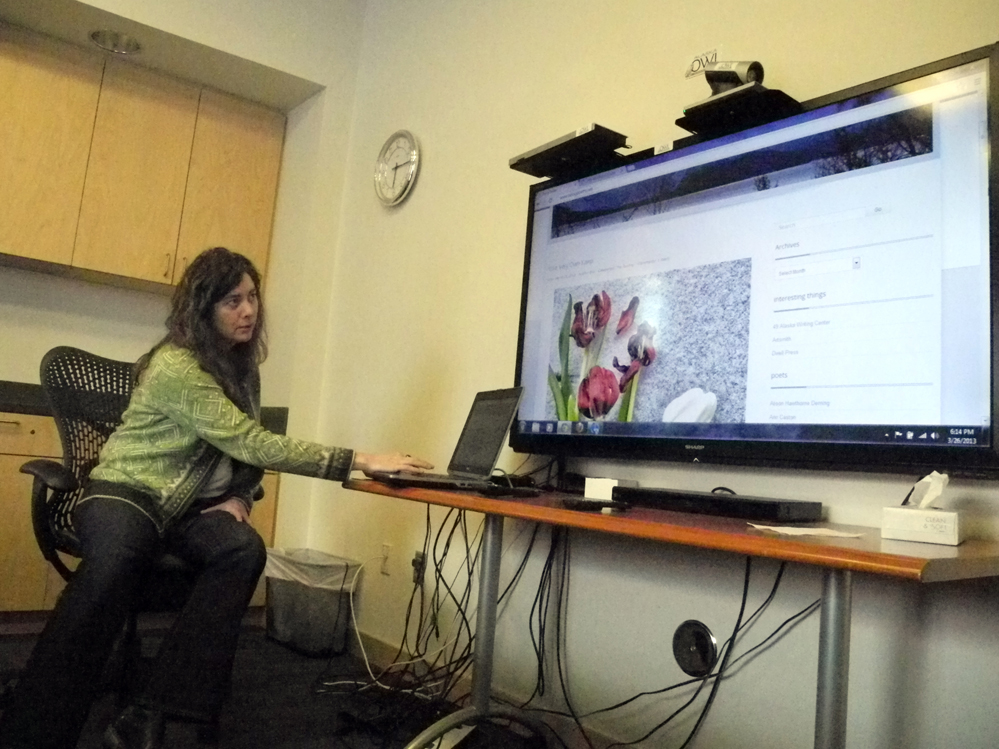BY MICHAEL ARMSTRONG
STAFF WRITER
Around and about Homer, not everything exists in the physical universe — at least, the universe beyond some server farm on a distant node of the information superhighway. Almost forgotten among social media websites is one of the earliest incarnations of the Internet, the blog. Of millions of blogs, some are by Homer writers or about Homer.
Welcome to the Homer blogosphere.
Do a web search on “Homer Alaska blogs,” and 5.2 million results pop up on Google. A quick glance at those blogs shows many of them discuss Homer or the lower Kenai Peninsula only in passing — an entry in a tourist’s travel journal, say. Some are by people who used to live here. Others take a writer’s perspective, the literary blog.
Poet Erin Coughlin Hollowell writes one of the most consistent literary blogs, “Being Poetry.” On March 26, Hollowell — also the Friends of the Homer Public Library coordinator — presented “Get Lit Blogging,” a talk for writers on how to start their own blog. A half-dozen writers listened to her advice.
In terms of the bits and bytes of the Internet, a blog is functionally the same as a web page, but that’s only because web pages borrowed some of the software architecture of the blog, Hollowell said. A blog or a section of it can even look like a web page.
The word itself comes from a combination of “web” and “log.” Web pages used to be static. Blogs changed that, introducing a way to make periodic updates and for readers to comment on blog entries. Web page designers then added that feature.
“That interaction is primarily based on blogs,” Hollowell said.
What makes a blog different from a web page is its intent, Hollowell said.
“It’s just how you put it up,” she said. “When you think blog, I want you to think interactive.”
Blogs also differ from web pages in an important way: they’re easier to create. Blogging software doesn’t get muddled down in writing code. Blog entries can be written in word processing programs like Word. To find blogging software, search “best free blogging software,” Hollowell said. She uses WordPress.com, also the name of a blog site.
Bloggers — the word for someone who blogs — can use free blogging sites like WordPress, Blogger and Live Journal. Those have limits on server space, though.
Hollowell created her blog because she wanted to promote her professional writing career. Her first poetry collection, “Pause, Traveler,” officially comes out April 20, but already is on sale at the Homer Bookstore. Because she wanted control of her blog, Hollowell pays $16 a month to have it on a web hosting site, Network Solutions.
In her talk, Hollowell showed how to set up a blog. She opened up what’s called the dashboard of the blog.
“Or, as I like to call it, ‘behind the curtain,’” she said.
On the dashboard, things like a blog’s theme — its assortment of layouts and fonts — can be chosen. Usually, a blog has a main section, with the blog’s title, an illustration and buttons called “widgets” that open up sections or new blog pages. On “Being Poetry,” an “about me” page looks like a web page, with a photo of Hollowell and basic biographical information. Hollowell suggested not getting fussy.
“Just pick a really clean theme that’s easy and makes you happy,” she said.
To keep a blog fresh, Hollowell offered the eternal advice to writers: write. She said to think of each post as a notebook page.
Bloggers should ask themselves questions, like “Why do you want to blog?” and “What should you put on your blog?” Blogs are usually public, so the blogger should think about how public is the blog.
“Your comfort level is your comfort level,” Hollowell said.
Another blogger at the talk, Teresa Sundmark, said she started her blog, “Lofty Minded in Alaska,” as a way to force herself to write. A student in the University of Alaska low-residency writing program, Sundmark also works at the library.
“I was not very tech savvy and I decided to do this,” Sundmark said. “It’s not a big scary thing.”
To keep blogs fresh, Hollowell suggested setting up periodic projects. Her blog has things like “Wonder Wednesdays,” when every Wednesday she writes about something that inspires her in the world. For April, National Poetry Month, each day she’s writing a poetry prompt.
One nice thing about blogs and blogging software is that they’re also easily fixed, Hollowell said.
Once set up, blogs can take on a life of their own, Hollowell said. That can be both a blessing and a curse for a writer, she cautioned.
“It’s endless,” she said. “But you also could just write.”
Michael Armstrong can be reached at michael.armstrong@homernews.com.
Local blogs:
Becoming Alaskan,
by Sarah Richardson
homeralaska.com/stories/BecomingAlaskan.shtml
Being Poetry,
by Erin Coughlin Hollowell
www.beingpoetry.net
Hannanigans,
by Hannah Heimbuch
hannanigansalaska.blogspot.com
Lofty Minded in Alaska,
by Teresa Sundmark
loftyminded.com
The Wandering Stethoscope,
by Janna Wagner
www.thewanderingstethoscope.blogspot.com
Blogging sites:
WordPress
wordpress.com
Blogger
www.blogger.com
Live Journal
www.livejournal.com


